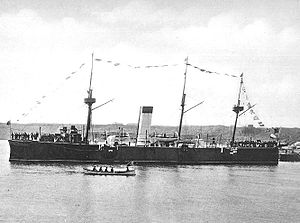NMS Elisabeta
 Elisabeta before her 1904–05 refit | |
| Class overview | |
|---|---|
| Builders: | Armstrong, Elswick |
| Operators: | 22x20px Romanian Naval Forces |
| In commission: | 1888–1915 |
| Planned: | 1 |
| Completed: | 1 |
| Scrapped: | 1 |
| Career (Romania) | 100x35px |
| Name: | Elisabeta |
| Namesake: | Queen Elisabeta of Romania |
| Builder: | Armstrong, Elswick |
| Completed: | September 1888 |
| Commissioned: | October 1888 |
| Decommissioned: | c. 1915 |
| Fate: | Scrapped 1926 |
| General characteristics | |
| Type: | Protected cruiser |
| Displacement: | 1,330 long tons (1,351 t) |
| Length: | 239 ft 10 in (73.10 m) |
| Beam: | 33 ft 6 in (10.21 m) |
| Draft: | 12 ft 6 in (3.81 m) |
| Propulsion: |
2-shaft Triple expansion steam engines 4 cylindrical boilers 2,500 ihp (1,864 kW) |
| Speed: | 18 knots (21 mph; 33 km/h) |
| Complement: | 170 |
| Armament: |
4 x 1 - 15-centimeter (5.9 in)/35 Krupp guns 4 x 1 - 57-millimeter (2.2 in) Nordenfelt guns 4 x 1 - 37-millimeter (1.5 in) Hotchkiss guns 4 x 1 - 356-millimeter (14.0 in) torpedo tubes |
| Armor: | Deck: 1–3.4 in (25–86 mm) |
NMS Elisabeta was a small protected cruiser built by Armstrong for Romania in the 1880s. Serving mainly as a training ship, she represented Romania at the opening of the Kiel Canal in 1895. She helped protect Romanian interests in Constantinople during the First Balkan War in 1912–13, but played no significant part in the Second Balkan War and was disarmed and hulked at the beginning of World War I. Employed as a barracks ship after the war, she was scrapped in 1926.
Description
Elisabeta was built of steel and measured 239 feet 10 inches (73.10 m) long overall.[1] She had a beam of 33 feet 6 inches (10.21 m)[2] and a draft at the bow of 11 feet 6 inches (3.51 m) that increased to 12 feet 6 inches (3.81 m) at the stern. She displaced 1,330 long tons (1,351 t) at full load.[1]
Elisabeta had two triple expansion steam engines driving 9-foot-8-inch (2.95 m) screw propellers. Four cylindrical boilers provided steam to the engines. The engines had a normal designed output of 2,500 ihp (1,864 kW) or 4,700 ihp (3,505 kW) using forced draft.[1] During her trials on 14 September 1888, Elisabeta had a top speed of 19.049 knots (35.279 km/h; 21.921 mph), but she averaged 18.053 knots (33.434 km/h; 20.775 mph).[3] She carried 322 long tons (327 t) of coal.[1]
Elisabta's main armament consisted of four single 15-centimeter (5.9 in)/35-caliber Krupp breech-loading guns on pivot mounts in semi-circular sponsons on the side of the ship. She carried four single 57-millimeter (2.2 in) Nordenfelt guns, two each in the bow and stern. She also carried four 37-millimeter (1.5 in) Hotchkiss guns.[4] Four 356-millimeter (14.0 in) above-water torpedo tubes were also fitted, one each in the bow and stern and one on each broadside.[1]
Her protective deck was 1.7 inches (43 mm) thick on the flat and increased to 3.4 inches (86 mm) on the slopes. It tapered to 1 inch (25.4 mm) at the ends of the ship.[1]
Service
Elisabeta sailed for Romania at the end of October 1888, arriving there about three weeks later,[3] and received her armament at the Galaţi Naval Arsenal.[4] She made several summer training voyages around the Black Sea in 1889 and 1890. At the beginning of 1891 she began a five-month cruise in the Mediterranean. She represented Romania at the 1892 Columbus celebrations of Livorno, Barcelona and Lisbon. In 1894 she made a short cruise in the Black Sea followed by a longer Mediterranean cruise. Elisabeta sailed for Kiel in 1895 to participate in the opening celebration of the Kiel Canal and continued on to Stockholm where she was inspected by the King of Sweden. She made the first Romanian survey of their coast in 1898[5] and underwent a major refit at Galaţi in 1904–05 where her sailing rig was reduced to two pole masts.[6]
Elisabeta's armament was exchanged for four French Saint-Chamond 120-millimeter (4.7 in) and 75-millimeter (3.0 in) guns in 1907.[6] She was in Constantinople during the First Balkan War where she landed several shore parties to protect the Romanian Legation. After the end of the war she returned to Romania on 15 June 1913, only a day before Bulgaria began the Second Balkan War. She remained at Sulina to defend the mouths of the Danube during the war.[7] Disarmed when World War I began, her armament was emplaced on the Danube River to protect against possible attacks by Austro-Hungarian river monitors, and she remained in Sulina for the duration of the war. After the war she was used as a barracks ship at Galaţi and later at Sulina before she was sold for scrap in 1926.[6]
Notes
Bibliography
- Gardiner, Robert, ed (1979). Conway's All the World's Fighting Ships 1860—1905. New York: Mayflower Books. ISBN 0-8317-0302-4.
- Georgescu, Mihai (1984). "Elisabeta". Warship International (Toledo, OH: International Naval Research Organization) XXI (2): 158–67. ISSN 0043-0374.
- Greger, Rene (1984). "Elisabeta and her Armament". Warship International (Toledo, OH: International Naval Research Organization) XXI (2): 189–90. ISSN 0043-0374.
